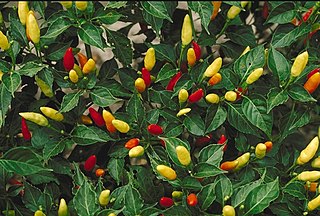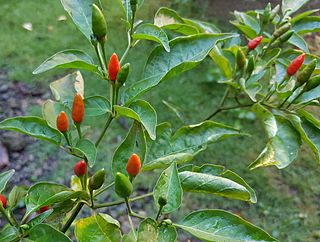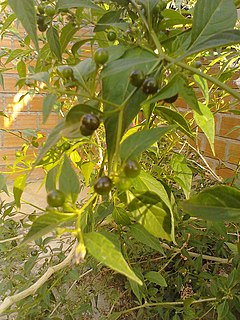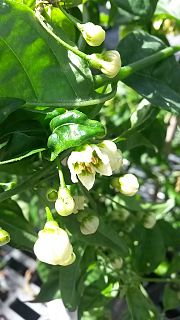
The Scoville scale is a measurement of the pungency of chili peppers, as recorded in Scoville Heat Units (SHU), based on the concentration of capsaicinoids, among which capsaicin is the predominant component. The scale is named after its creator, American pharmacist Wilbur Scoville, whose 1912 method is known as the Scoville organoleptic test. The Scoville organoleptic test is the most practical method for estimating SHU and is a subjective assessment derived from the capsaicinoid sensitivity by people experienced with eating hot chilis.

Capsaicin (8-methyl-N-vanillyl-6-nonenamide) is an active component of chili peppers, which are plants belonging to the genus Capsicum. It is a chemical irritant for mammals, including humans, and produces a sensation of burning in any tissue with which it comes into contact. Capsaicin and several related alkaloids are called capsaicinoids and are produced as secondary metabolites by chili peppers, probably as deterrents against certain mammals and fungi. Pure capsaicin is a hydrophobic, colorless, highly pungent, crystalline to waxy solid compound.

The bell pepper is the fruit of plants in the Grossum cultivar group of the species Capsicum annuum. Cultivars of the plant produce fruits in different colors, including red, yellow, orange, green, white, and purple. Bell peppers are sometimes grouped with less pungent pepper varieties as "sweet peppers". While they are fruits—botanically classified as berries—they are commonly used as a vegetable ingredient or side dish.

The chili pepper, from Nahuatl chīlli, is the fruit of plants from the genus Capsicum which are members of the nightshade family, Solanaceae. Chili peppers are widely used in many cuisines as a spice to add heat to dishes. The substances giving chili peppers their intensity when ingested or applied topically are capsaicin and related compounds known as capsaicinoids.

Capsicum pubescens is native to Bolivia, Peru and Ecuador and dates back to pre-Incan times; traces of its presence have been found in the Guitarrero Caves. The existence of Capsicum pubescens was documented by ancient Peruvians of the Paracas, Nazca, Moche, and Chimu cultures, through textiles, ceramics, and domestic remains. This chili pepper is the most important ingredient of the Bolivian sauce llajwa. It is also considered the flagship of Peru and it is consumed fresh, paste, dried, or ground. It belongs to a species of the genus Capsicum (pepper), and is known in Peru and Ecuador as rocoto, locoto in Bolivia and Argentina and as the manzano pepper in Mexico which means 'apple' for its apple-shaped fruit. This species is found primarily in Central and South America, and is known only in cultivation. The species name, pubescens, means hairy, which refers to the hairy leaves of this pepper. The hairiness of the leaves, along with the black seeds, distinguish this species from others. As they reach a relatively advanced age and the roots lignify quickly, sometimes they are called tree chili. Of all the domesticated species of peppers, this is the least widespread and systematically furthest away from all others. It is reproductively isolated from other species of the genus Capsicum. A very notable feature of this species is its ability to withstand cooler temperatures than other cultivated pepper plants, although it cannot withstand frost.

Capsicum annuum is a species of the plant genus Capsicum native to southern North America and northern South America. This species is the most common and extensively cultivated of the five domesticated capsicums. The species encompasses a wide variety of shapes and sizes of peppers, both mild and hot, such as bell peppers, jalapeños, New Mexico chile, and cayenne peppers. Cultivars descended from the wild American bird pepper are still found in warmer regions of the Americas. In the past, some woody forms of this species have been called C. frutescens, but the features that were used to distinguish those forms appear in many populations of C. annuum and are not consistently recognizable features in C. frutescens species.

Capsicum frutescens is a wild chili pepper having genetic proximity to the cultivated pepper Capsicum chinense native to the Amazon Basin. Pepper cultivars of C. frutescens can be annual or short-lived perennial plants. Flowers are white with a greenish white or greenish yellow corolla, and are either insect- or self-pollinated. The plants' berries typically grow erect; ellipsoid-conical to lanceoloid shaped. They are usually very small and pungent, growing 10–20 millimetres (0.39–0.79 in) long and 3–7 millimetres (0.12–0.28 in) in diameter. Fruit typically grows a pale yellow and matures to a bright red, but can also be other colors. C. frutescens has a smaller variety of shapes compared to other Capsicum species. C. frutescens has been bred to produce ornamental strains because of its large quantities of erect peppers growing in colorful ripening patterns.

Capsicum chinense, commonly known as a "habanero-type pepper", is a species of chili pepper native to the Americas. C. chinense varieties are well known for their unique flavors and many have exceptional heat. The hottest peppers in the world are members of this species, with Scoville Heat Unit scores of over 2 million. Some taxonomists consider them to be part of the species C. annuum, and they are a member of the C. annuum complex; however, C. chinense and C. annuum pepper plants can sometimes be distinguished by the number of flowers or fruit per node – two to five for C. chinense and one for C. annuum – though this method is not always correct. The two species can also hybridize and generate inter-specific hybrids. It is believed that C. frutescens is the ancestor to the C. chinense species.

Capsicum baccatum is a member of the genus Capsicum, and is one of the five domesticated pepper species. The fruit tends to be very pungent, and registers 30,000 to 50,000 on the Scoville Heat Unit scale.

Siling labuyo is a small chili pepper cultivar that developed in the Philippines after the Columbian Exchange. It belongs to the species Capsicum frutescens and is characterized by triangular fruits which grow pointing upwards. The fruits and leaves are used in traditional Philippine cuisine. The fruit is pungent, ranking at 80,000 to 100,000 heat units in the Scoville Scale.

The facing heaven pepper or Heaven Chile, is a cone-shaped, medium-hot chili pepper, between 3 and 6 cm in length, 1 to 2 cm in diameter at the base, and with very thin skin. It is a variety of Capsicum annuum that is native to Central America. Common names include conic, facing heaven, and biberi peppers. It has 2n=2x=24, native to the New World. However, this variety is most common in parts of eastern Europe, e.g., Turkey, and eastern Asia, e.g., China.

Solanoideae is a subfamily of the flowering plant family Solanaceae, and is sister to the subfamily Nicotianoideae. Within Solanaceae, Solanoideae contains some of the most economically important genera and species, such as the tomato, potato, eggplant or aubergine, chili and bell peppers, mandrakes, and jimson weed.
William Hardy Eshbaugh III is Professor Emeritus of Botany at Miami University, known primarily for his research on chili peppers and one of three authors of the seminal work covering the flora and biogeography of the Bahamas.

Capsicum is a genus of flowering plants in the nightshade family Solanaceae, native to the Americas, cultivated worldwide for their chili pepper or bell pepper fruit.

The Solanaceae, or nightshades, are a family of flowering plants that ranges from annual and perennial herbs to vines, lianas, epiphytes, shrubs, and trees, and includes a number of agricultural crops, medicinal plants, spices, weeds, and ornamentals. Many members of the family contain potent alkaloids, and some are highly toxic, but many—including tomatoes, potatoes, eggplant, bell and chili peppers—are used as food. The family belongs to the order Solanales, in the asterid group and class Magnoliopsida (dicotyledons). The Solanaceae consists of about 98 genera and some 2,700 species, with a great diversity of habitats, morphology and ecology.

The cayenne pepper is a type of Capsicum annuum. It is usually a moderately hot chili pepper used to flavor dishes. Cayenne peppers are a group of tapering, 10 to 25 cm long, generally skinny, mostly red-colored peppers, often with a curved tip and somewhat rippled skin, which hang from the bush as opposed to growing upright. Most varieties are generally rated at 30,000 to 50,000 Scoville units.

Capsicum cardenasii is a plant species in the genus Capsicum and the family Solanaceae. It is a diploid with 2n=2x=24. It is a member within the C. pubescens complex, a group of closely related Capsicum species. It is closely related to C. eximium. It is native to the Andes, and it can be found in Bolivia and Peru. The native name is ulupica.

Capsicum rhomboideum is a perennial member of the genus Capsicum with 2n=2x=26, and is considered a distant wild relative of the chili pepper. Its fruit do not have any pungency, and are a 0 on the Scoville Heat Unit scale. It gets its name from the rhomboidal to elliptical shape of its leaves. It is native to Mexico, Central America, and Andean region of South America.

Capsicum flexuosum is a member of the genus Capsicum, and is native to the New World, specifically the southern regions of Brazil. Unlike most other chili peppers, it is only mildly pungent and has issues with self-compatibility.

















